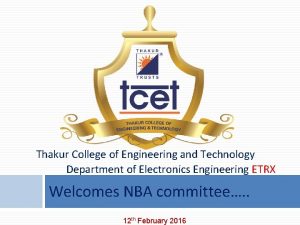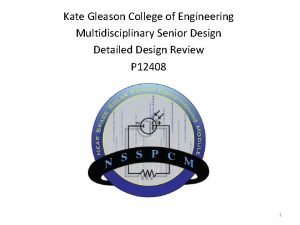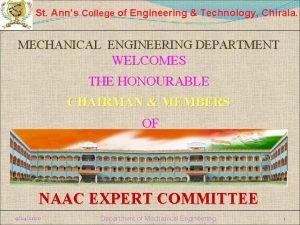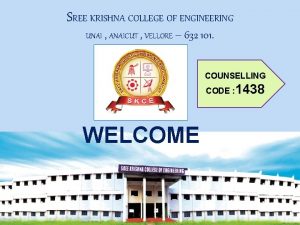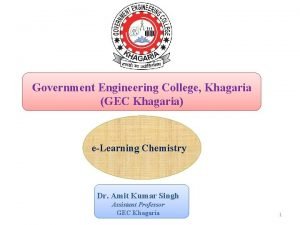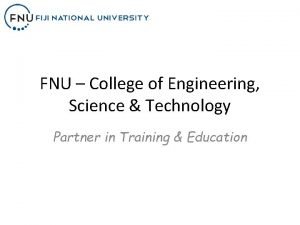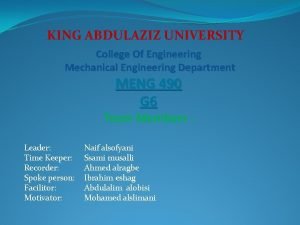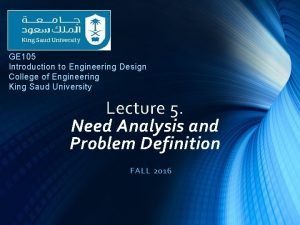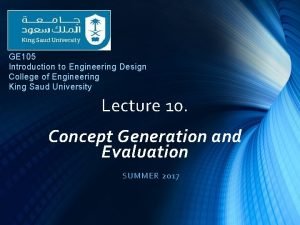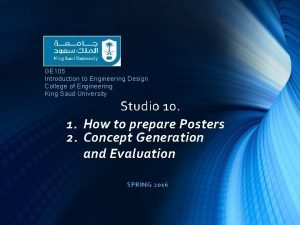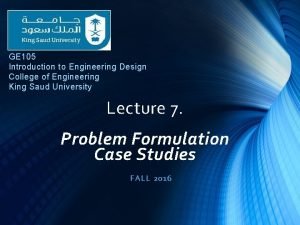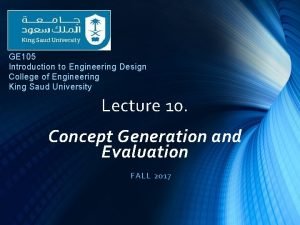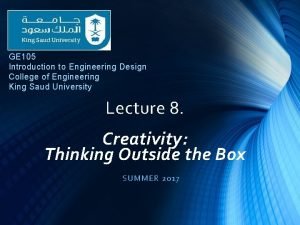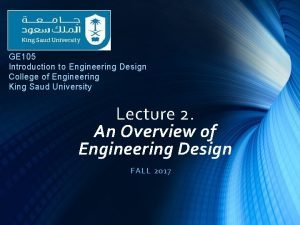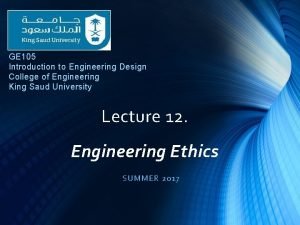GE 105 Introduction to Engineering Design College of












- Slides: 12

GE 105 Introduction to Engineering Design College of Engineering King Saud University Lecture 1. Course Introduction FALL 2016 1

This course 2

Information • Credits: 2(1, 1, 2) • Prerequisites: GE 104 • Number of Sections: 12 • Given By: 10 Professors SUGGESTED BOOK E XPL OR I NG E N G I NE E R I N: G A N I N T R O D UC TI O TNO E NG I N E E R I NG AN D D E S I G N( F O U R TH E D I T I ON) B Y: P H I L I P K O S KY , R O B E R T T. B A L M E R , W I LLI A M D. K E A T , G E OR G E W I S E • Your Instructor: Dr. Ahmed M. El-Sherbeeny • Meetings • Lecture : Sundays 8: 00 -8: 50 am • Tutorial : Tuesdays 8: 00 -8: 50 am • Studio : Sundays 1: 00 -2: 50 pm, 3

Lecturing Styles Used • Lecture : “Normal” Classes • Studios: Design project classroom activities practicing various skills intensive discussions group dynamics • Tutorials: Help with homework assignments and exams Solving problems 4

Sources of Assistance • Your Instructor • Office number 2 A 128/1 • Office hours posted • Email: aelsherbeeny@ksu. edu. sa • Your Teaching Assistant • Lectures slides • Studios slides • Course materials on website (http: //fac. ksu. edu. sa/aelsherbeeny) • Your Textbook • Prince Salman Library • Internet 5

Relation to Other Courses Engineering Specializations requir ing GE 105: • Mechanical Engineering • Electrical Engineering • Petroleum and Gas Engineering • Civil Engineering • Chemical Engineering • Industrial Engineering (currently under consideration) g g GE 105 provides the basics for the final year project and gives the necessary skills for an engineering student g g EE 496/ME 496 EE 497/ME 497 6

Course Objectives • Formally Expose students to the engineering field • Grasp the values of professionalism, ethics, safety, intellectual property, environment, and human factors. • Introduce the design process, problem-solving skills, and practices dealing with openended problems • Enforce the skills in teamwork, group dynamics, critical thinking, planning, scheduling, and written/oral communications through the design project

Course Outline (Topics) • An Overview of Engineering Design • The Engineering Profession • Engineering Need Analysis • Problem Formulation • Creativity in Design : Thinking Outside the box • Concept Generation and Evaluation • Human Factors Engineering • Intellectual Property – Legal Factors • Engineering Ethics 8

Learning Outcomes (1. Knowledge) • Ability to use the engineering design process to carry out a project. • Ability to prepare a need-assessment, define and formulate the problem, consider the problem constraints, and specify a deliverable for a project. • Ability to solve open-ended design problems, cope with decision making and satisfy competing objectives. • Ability to synthesize gathered information to solve open-ended problems. • Ability to conceptualize alternative concepts, evaluate and select preferred alternative, and implement the preferred design using engineering tools. • Understand the importance of professional and ethical responsibility. • Understand ethics, environmental and legal issues. 9

Learning Outcomes (2. Cognitive Skills) • Ability to apply design heuristic of recognition of the problem, problem definition, design criteria, and design constraints • Ability to apply creative techniques to generate alternative solutions (concepts) • Ability to apply procedures to evaluate the solutions and select the "best" solution, decide on a course of action and implement the selected solution • Ability to synthesize and critically judge the relevant gathered information to solve open-ended problems • Ability to exercise professional and ethical responsibility in carrying out the design project • Ability to consider human factors and legal factors in the design problems 10

Learning Outcomes (3. Interpersonal Skills) • Ability to take the responsibility to solve given assignments on your own and submit the solution on time. • Ability to engage and work effectively in teams with full group interaction during the work on the design project, exercise full responsibility in holding team meetings, distributing tasks, leadership and team dynamics. • Ability to manage the time between self study, solving assignments, carrying out the design project activities, and submitting project reports. • Ability to find out the proper action when confronted with engineering ethical problems. 11

Grading • Classwork: 15% • Tutorial : 10% • Design Project: 35% • Presentation 15% • Report 10% • Poster 5% • Logbook 5% • Final Exam: 40% • Total 100% Required From St uden ts • Attendance ON TIME!!! • Assignments submitted on time • Contributing to all open classroom discussions • Quizzes • Design Project • Studios • Teamwork • Project Report • Joint Presentation Work Hard and Enjoy the Course ! s e s u c Ex t No • Meeting Logs Retention (logbook) s t l su e R e uc d Pro • Final Exam 12
 Wake tech admissions
Wake tech admissions Early college high school at midland college
Early college high school at midland college Zeal dnyanganga college of engineering and research
Zeal dnyanganga college of engineering and research Thakur college of engineering and technology
Thakur college of engineering and technology Kate gleason college of engineering
Kate gleason college of engineering Ucf computer engineering
Ucf computer engineering Tagore engineering college rathinamangalam
Tagore engineering college rathinamangalam St ann's engineering college chirala faculty
St ann's engineering college chirala faculty Sree krishna college of engineering vellore
Sree krishna college of engineering vellore Govt engineering college khagaria
Govt engineering college khagaria Fnu engineering courses
Fnu engineering courses College of engineering, king abdulaziz university
College of engineering, king abdulaziz university G h patel college of engineering and technology
G h patel college of engineering and technology



